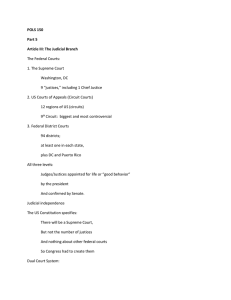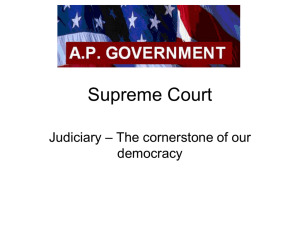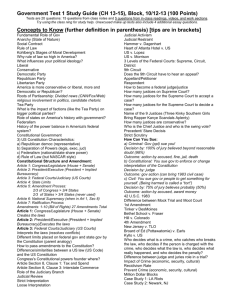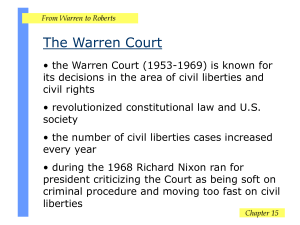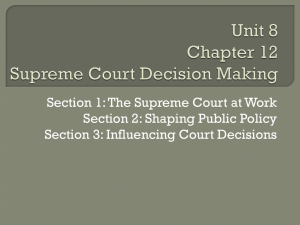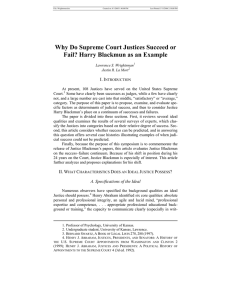File - Coach Burnett
advertisement
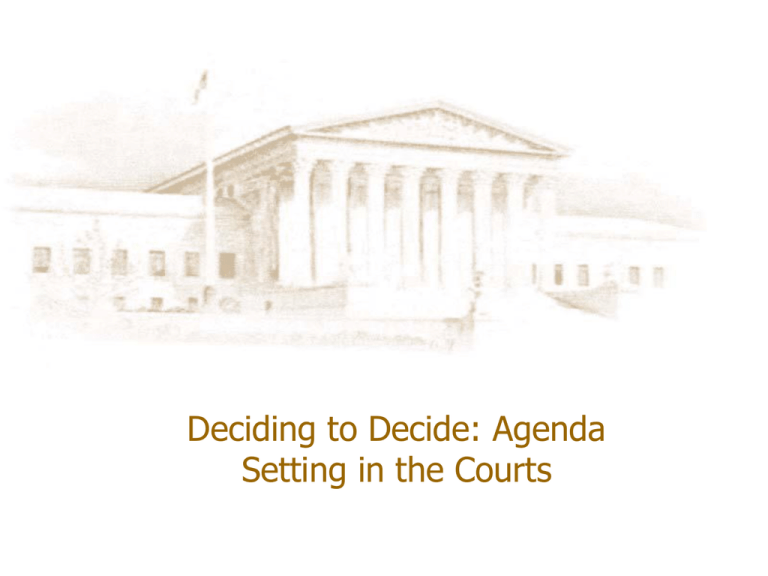
Deciding to Decide: Agenda Setting in the Courts Micro Level Theory vs. Macro Level Theory The focus is on the individual decision maker Liberal or conservative dimension (expanding or limiting rights) Decisions based on individual ideology and what they prefer to do Liberal judges stay liberal in all aspects, as conservative judges stay conservative • The focus is on the influence of the group, institution, or environment •Analysts must take into consideration the collegial influences of the judges as a collective group •Also consider the extent to which the Constitution must be upheld, legal limits, and possible actions •Must look into environmental issues, such as whether the nation is at war, political, social, and economic conflict. •Take into account public opinion, but do not always make a point to represent it Three functions that are the basis of decisions are: What they prefer to do What they ought to do What they perceive is feasible Thus, each judges’ decision is based on their individual values, what the nation needs at the time, and what the governmental action can actually achieve. What is the cue theory? Used to explain certiorari decisions of the Supreme Court Justices rely on “cues” as to which cases actually deserve more scrutiny Most influential cue is from the Solicitor General who prompts which cases are most worthy of consideration Amicus Curiae Briefs play a key role. Ex ACLU, NAACP Restraintism vs. Activism •Follow precedents •Strict construction to the constitution •Deference to legislative “intent” •Restraintist judges stick closely to the constitution and are averse to interpreting the Constitution as how it “ought to be” •Decisions are strongly predictable as they must be in line with the literal Constitution •These judges also show great divergence in their votes from their political values, as they feel their values should not interpret the constitution. •Subordination of precedents and statutes •Deference to personal attitudes, values, and goals •Based on the idea that judges make laws •Interpretation solves problems not considered or addressed by the legislature •“The question comes up, and you decide it.” – you don’t wait for the legislature •Decisions strongly predictable from the individual attitudes Constructional Constraints Must satisfy both formal and informal institutions Institutional Constraints Rule of Four Chief Justice sets the tone Must deal with the law, precedents and Constitution Justices interact as a group Environmental Constraints The structure of political, economic, and social conflict or war have much to do with the cases coming to the court. Judges are not expected to respond directly to public opinion, but they are in line with the public 60% of the time. Interest groups play a major role in the deliberations of judges as amicus curiae participants. Blue: Total cases on docket Red: Number of cases acted upon Granting Certiorari Presumption against granting cert 1. So little time, so many cases: Court will be selective 2. All cases are fungible: issues are important, not cases Judging a Case Uncertworthy “Nut cases” Frivolous Clear Denies Lack of percolation Bad Facts=Bad Vehicle Pipeline Intractability Judging a Case Certworthy Circuit Conflict Importance (one of a kind, societal impactserious question of constitutional law, civil liberties) Impacts many people Solicitor General’s encourages acceptance Public pressure Justice’s interest Flagrant abuses of justice Presence of amicus curiae briefs Factors that limit cases heard by Supreme Court Most cases previously heard Congress has power to limit court’s jurisdiction Court will not answer moot questions Parties have standing to sue Case must be ripe Court will not answer political questions Rule of Four Court will not accept local issues Cases fails to answer serious questions of constitutional law Expensive and emotional to take a case all the way Discuss List Internal mechanism to handle the large caseload. The chief justice circulates a “discuss list” of cases he deems worthy of discussion. Justices may add a case to the list. Each case presented to the Court is still reviewed in each justice's chambers, but only those cases on the discuss list are talked about at the justices' regular conference. Approximately 30 percent of the filed cases reach the discuss list. The remaining requests for review are rejected, without further consideration. Discuss List Justices will place cases on the Court’s discuss list when the lower court’s decision, the status quo, is contrary to their preferences. Scholars have identified two dimensions to using the docket-selection process as agenda setting: 1) Justices seek cases that they can use to advance their policy goals; 2) Justices strategically seek cases where the Court will render favorable decisions. americandemocracy.nd.edu/workshops/documents/Schoendiscusslists.pdf Justices Listing Cases Justice William H. Rehnquist (Associate Justice) (Chief Justice) Warren E. Burger Byron R. White John Paul Stevens Sandra Day O’Connor William J. Brennan, Jr. Harry A. Blackmun Antonin Scalia Anthony M. Kennedy Thurgood Marshall Ruth Bader Ginsburg Lewis F. Powell David H. Souter Clarence Thomas Number of cases listed Percent of cases listed 1985-1993 5,035 19 5 ,016 819 1,043 477 368 60.1 9.8 12.5 5.7 4.4 216 214 129 34 19 12 7 2 1 Total 8,378 2.6 2.6 1.5 0. 4 0.2 0.1 0. 0 0. 0 0.0 100.0 Percent of total during tenure 60.1 (1985-1993) 1.6 (1985) 69.8 (1986-1993) 68.8 (1985) 13.3 (1985-1992) 5.7 (1985-1993) 4.4 (1985-1993) 4.3 (1985-1989) 2.6 (1985-1989) 1.8 (1986-1993) 0.6 (1987-1993) 0.3 (1985-1990) 2.2 (1993) 0.3 (1985-1986) 0.1 (1990-1993) 0.0 (1991-1993) The Impact of Judicial Policies Policies that have had significant effects on “society as a whole” includes: The courts’ role in developing a policy of racial equality: segregation, busing, employment, reverse discrimination Legislative reapportionment In 1962, Supreme Court ruled that malapportionment presented a judicial question during the Baker v. Carr decision, which eventually called for reapportionment as the remedy. (Impact continued…) Criminal due process Judicial policy-making in this area is most closely associated with the Warren Court period. Mapp v. Ohio extended the exclusionary rule, which had applied to the national government for a number of years, to the states. Required state courts to exclude from trials evidence that had been illegally seized by the police. Gideon v. Wainwright decision held that indigent defendants must be provided attorneys when they go to trial in a felony case in the state courts. Miranda v. Arizona went a step further when the Supreme Court ruled that police officers must advise suspects taken in to custody of their constitutional rights. Abortion The Court’s decision in Roe v. Wade concerning abortion was naturally controversial. Later courts would modified abortion guidelines (Planned Parenthood v Pennsylvania) (Impact Continued…) Religion: Again, judicial policy-making in this area is closely related to the Warren Court. Most decisions were tied to public schools, but later cases would address religion in the workplace, Sabbath, and religious practices Policies of Past Courts Hughes’ Court 1930-1941 Evolution and Revolution Sitting l. to r.: McReynolds, Holmes, Hughes, Van Devanter, Brandeis. Standing l. to r.: Stone, Sutherland, Butler, Roberts The Justices The Four Horseman Swingman Sympathetic Sutherland, Butler McReynolds, Van Devanter Hughes Roberts Brandeis Stone Cardozo FDR and the Court Packing Plan FDR’s response to the Great Depression was the growth of the federal government that would regulate business, labor laws, child labor, minimum wage, and job programs. Court rules that the New Deal programs violates the 10th Amendment Impact of the Hughes Court Considered the first modern court because of its deference toward economic legislation and the vigorous guardianship of personal liberties Famous footnote 4 in US v Carolene Products, 1937- more exacting judicial scrutiny under provisions of 14th Amend. Incorporates press, assembly, free exercise Right to attorney in death penalty cases Warren Court 1953-1969 The Warren Court, 1966 Back row, L to R: Justices White, Brennan, Stewart, Fortas Front Row, L to R: Justices Clark, Black, Warren, Douglas, Harlan Two Warren Courts 1953-1962- Brown v Topeka Bd of Ed, and national security cases, and political reaction to court’s decision, procedural fairness in governmental process 1962-1969- Firmly in the hands of the liberals and centered on individual freedoms 18 justices served during this 16 year period “Worse Damn Mistake I Ever Made” Warren Court moves to the left: Brown v Board of Education Baker v Carr One man, one vote Rights of the Accused Extended: 1. Gideon v Wainwight 2. Miranda v Arizona 3. Mapp v Ohio Burger Court, 1969-1986 Sitting l. to r.: Harlan, Black, Burger, Douglas, Brennan. Standing l. to r.: Marshall, Stewart, White, Blackmun The Burger Court 1969-1986 Began to narrow the rights of the accused that were won in the Warren Court. Most noted for Roe v Wade and US v Nixon Extended rights for women Rehnquist Court, 1986-2005 Sitting l. to r.: O'Connor, Blackmun, Rehnquist, Stevens, Scalia. Standing l. to r.: Thomas, Kennedy, Souter, Ginsburg. Radical Revision of Constitutional Law Chipped away at liberal decisions, such as, abortion rights and affirmative action. Overturned cases which extended the Congress’ commerce power Decline in number of cases Supreme Court justices are as independent as hogs on ice. You can't herd them. Impact of Rehnquist Court Strict Construction- Rehnquist, Scalia, Thomas (Sometimes Kennedy and O’Connor) Loose Construction- Brennan, Marshall 1992-2002 Court overturns more Congressional statutes that any other court with the exception of the 17 years of Burger’s court (Court activism) Rolling back the commerce clause and supporting states’ rights US v Lopez and US v Morrison Credits Deciding to Decide: Agenda Setting in the United States Supreme Court: H.W., Jr. Perry: Books Lessons for important cases: Mapp, Gideon, Brown, Korematsu, Miranda, MuCulloch, Texas v Johnson, Roe v Wade, US v Nixon can be found at http://www.landmarkcases.org/index.html Flag cases-Lesson http://www.getty.edu/education/for_teachers/curricula/dorothea_lange/lange_lesson04.html Photos of court- Supreme Court Historical Society “Decision Making in Appellate Courts” by James L Gibson



